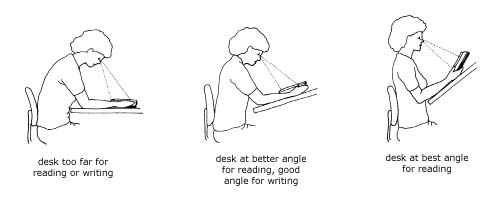Vision is the most powerful determinant of your posture at work. Thoughtful placement of your computer and documents within your field of view, is critically important. The placement of your work materials and equipment can have greater impact on your posture than a new ergonomic chair.

Your body follows your eyes. To preserve good posture, your visual target should be nearly parallel to your face and within your line of sight. Poor visual target position forces your spine to compensate by bending. It is physically impossible to sit in an erect posture and write on a flat surface at the same time!
Focus angle
Reading angles. The ideal reading angle is about 60° from the horizontal, give or take. If you wear bifocals or if your upper back is rounded (e.g., kyphotic), your line of sight may be lower and your reading angle more flat.
Writing angles. The ideal writing angle is somewhere between 10° and 20°. This is not ideal for vision and your spine, as both your neck and back have to bend forward somewhat. However, writing at a steeper angle can strain your shoulder and neck muscles. Artists and draftsmen often find ways to write or paint at steeper angles to protect their backs and necks. They do better if they can support their arms directly on the writing/painting surface as they work.

Body postures follow the the eyes.
After Grandjean, Kahlick and Wotzka [111 Fig. 36]
Focus distance
Each of us experiences our own best visual acuity at a certain distance.
Focus distances for reading and writing to paper average between 15" to 25" from the eyes. All of us are a little different. If your visual acuity point is at 16 inches, you will strain your body forward to focus on work that is more than 17 inches away.

The desk is too low. The chair is a perfect fit, but the desk is not.

The desk is at the proper height.

The microscope too far away. The chair fits, but the visual target is too far away.

The microscope is the proper distance from the eye.
Focus distances for computer viewing are greater than for reading and writing. Research suggests there is less eye strain when your computer monitor at least 30" from your eyes.

Older computer monitors had poor screen resolution and were hard to see at a healthy distance.
In the "old" days, just a few short years ago, computer monitor resolution was too poor to allow an ideal focus distance. Newer computer monitors with better resolution can be seen at greater distances, and the text can be made enlarged to make distant viewing easier. However, if you have a traditional box-style CRT, your desk is probably not deep enough to allow you to place it that far away from you. If this is your problem, consider a detached keyboard support -- or trade up your klunky old monitor for a new flat panel display -- or invest in a deeper desk.
Article reproduced with permission from ergoTALK.